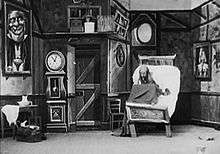The Inn Where No Man Rests
L'Auberge du bon repos, sold in the United States as The Inn Where No Man Rests and in Britain as The Inn of "Good Rest",[1] is a 1903 French short silent comedy film by Georges Méliès. Set in an inn, the film addresses the state of the drunken mind with light heartedness.
| L'Auberge du Bon Repos | |
|---|---|
 | |
| Directed by | Georges Méliès |
| Starring | Georges Méliès |
Production company | |
Release date | June 27, 1903 (United States) |
Running time | 100 meters |
| Country | France |
| Language | Silent |
Synopsis
The film begins in the interior bedroom of an inn. There enters a traveler, slightly intoxicated, accompanied by a porter, who carries his baggage. The traveler takes off his hat, his coat and his shoes. The servant places these things upon a clothes-rack in such a way that they resemble the outlines of the back of an old codger. The servant withdraws. A comedic scene follows when the drunken chap tries to light his pipe from a candlestick. The candlestick rises in the air, and the flame is put out by a portrait placed in a frame on the wall. The guest lights the candle, and he tries to light his pipe again. A second time the candlestick rises up, and the personage in the picture having become animated swallows candle and candlestick. The fellow jumps backward, bumps up against the clothes-rack. Taking his clothes for an intruder he kicks at them. The boots become animated, and kick him in return. The fellow, enraged, throws himself upon the clothes-rack, which he imagines to be a person, struggles with it and rolls upon the floor, entangled among all his clothes.
He restores everything to its former place, but his boots began to dance about the room. The poor drunk man chases after them, but the boots ascend the wall and disappear in the ceiling. Tired he goes to bed. Immediately the bed begins to dance wildly about the room, then falls upon him, burying him among the covers, mattress and the pieces of the bed. He extricates himself in a rage, restores everything to order again, but just as he attempts to get into bed he finds himself suddenly thrown under it. He crawls out of bed and spies the Moon through the casement window. Believing that he has discovered an enemy he strikes the window with a broom, and the window bursts into pieces. The moon reappears on the dial of a clock; then suddenly it assumes the face of a grinning clown. The drunken fellow starts back; he stumbles against a valise. With a kick he sends the valise into the air, where it assumes the form of a demon, whom the fellow tries to catch. The furniture, washbowl, and pitcher break into pieces.
Awakened by the mid-night disturbances, the hotel manager and all the guests, enter the room. Stormy explanations follow, and a battle ensues. The people follow one another, leaping through windows, pictures and mirrors. The proprietor is hit on the head by a board laden with all sorts of objects, and a large portrait falls upon his head. Finally at the moment when the drunken fellow is on the point of being seized, he disappears through a casement and takes refuge on the roof, to the astonishment of all.
Production
The Inn Where No Man Rests is an expanded version of an earlier Méliès film, The Bewitched Inn (1897). The Moon and a manic chase, as featured in the film, are both common motifs in Méliès's work. As usual for his films, the chase here is circular, within a single set; however, Méliès did eventually try the linear, multi-scene chase format of his contemporaries (such as Ferdinand Zecca and Lucien Nonguet) in his film A Desperate Crime.[2]
Méliès himself plays the traveler in the film. The table and pendulum are animated using stage machinery; other objects are pulled or suspended using wire, and additional effects are worked using substitution splices. [2] The Inn Where No Man Rests was sold by Méliès's Star Film Company and is numbered 465–469 in its catalogues.[1]
References
- Malthête, Jacques; Mannoni, Laurent (2008), L'oeuvre de Georges Méliès, Paris: Éditions de La Martinière, p. 345, ISBN 9782732437323
- Essai de reconstitution du catalogue français de la Star-Film; suivi d'une analyse catalographique des films de Georges Méliès recensés en France, Bois d'Arcy: Service des archives du film du Centre national de la cinématographie, 1981, pp. 125–26, ISBN 2903053073